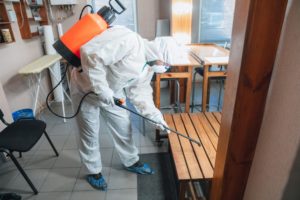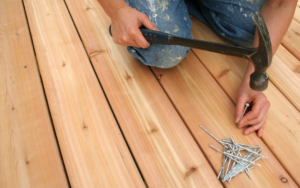Pests are unwanted organisms such as insects, rodents, weeds, viruses or nematodes that damage property or threaten human health. Pest control is the practice of preventing and/or eliminating pests.
Physical methods such as traps and barriers help limit pest populations. These methods work best when you know a pest’s preferred habitat and travel routes. Contact Pest Control Boise now!

Pests are organisms that interfere with human activities by consuming or damaging crops, plants, livestock and household products. Some pests also spread disease. The goal of pest control is to reduce their numbers below the level that causes unacceptable harm. Prevention, suppression and eradication are often used in combination to achieve this goal.
Preventing pest infestations starts with eliminating their access to food, water and shelter. This includes storing food in airtight containers, removing garbage regularly and fixing leaky plumbing. It also includes regular exterior inspections for cracks in foundation walls, screens on windows, roof gaps and utility line entrances to prevent ants, mice and other pests from entering the house.
Natural forces such as climate, natural enemies, the availability of food and water and geographic features influence pest populations. Some factors help to keep pest populations low, while others make them grow rapidly and become a nuisance or even a threat to humans and property.
Threshold-based decision making is one of the best ways to determine whether or not action is necessary to reduce pest population levels. For example, noticing a few wasps flying around the yard occasionally doesn’t warrant any action; but observing them on a daily basis and in increasing numbers may indicate that their presence should be addressed by locating and destroying their nest.
Understanding pest life cycles is another important aspect of prevention. The lifespans and developmental stages of pests (egg, nymph, adult) differ significantly from the lives and growth stages of desired organisms. Knowing this allows you to develop control methods that address only the target organisms and minimize impacts on non-target species.
A variety of pesticides can be used to prevent or suppress the presence of unwanted organisms. Some are absorbed through the skin and other tissues, while others are sprayed on surfaces or into the air to repel or kill pests. Pesticides should always be chosen and applied with a clear awareness of the potential risks to human health, beneficial insects and other organisms.
Some plants, trees, grass and animals are naturally resistant to pests. Using these types in landscaping can help to reduce the need for pesticides.
Suppression
When preventive steps fail to keep pests out of homes, gardens and other human spaces, people try to control their numbers using different methods. These tactics include exclusion, quarantine and repulsion as well as chemical controls. The goal is to minimize the pest’s impact on the environment without harming humans. The process is called hygiene management, and it looks at a pest’s place in the ecosystem as well as its role in damaging the areas where people live and work.
Pests come in all shapes and sizes and can damage food crops, gardens, and other human-occupied spaces. They also carry diseases and can cause allergies and asthma attacks. They also contaminate foods and other daily-use items by leaving traces of their faeces. These traces are often invisible to the naked eye and can only be detected with specialized laboratory equipment.
Some features of the landscape restrict the spread of some pests, including mountains and bodies of water. The availability of food, shelter and overwintering sites also affects pest populations. Pests may be affected by weather conditions, especially temperature and day length, which can alter their activity or reproduction rates.
Predatory and parasitic organisms are often natural enemies of pests and can control their numbers through predation or parasitism. Pathogens can also suppress pest populations. People sometimes augment these natural processes by introducing the predators or pathogens in a controlled setting. This is known as classical biological control and can be used in conjunction with prevention and eradication approaches.
Other natural means of controlling pests include the use of nematodes, which are microscopic worms that live in the soil and feed on insects. The nematode Steinernema carpocapsae, for example, kills roaches, beetles, grubs, fleas and other common garden pests by injecting them with a bacteria that breaks down their cell walls.
Another method of biological control involves releasing the pest’s natural enemies into the environment in large numbers in a single release. The aim is to supplement the natural enemy population and increase its ability to control the pest. This is usually not as effective as eradication, however, because there is often a time lag between the increase in the pest population and the corresponding increase in the natural enemies.
Eradication
Pests are a common issue for businesses and individuals alike. The problem is that they can spread diseases and contaminate food, water, and other items that we use in our daily lives. They also cause significant damage to property and are known to cause serious health issues like asthma. This is why it’s important to eradicate them before they get out of hand.
A professional pest control company is able to help you get rid of these pesky creatures before they become a major nuisance in your life. The best way to do this is by using natural methods that are safer for the environment and your family. However, this method is not as quick or effective as the chemical ones.
The most common pest problems are insect infestations, which are often the result of improper maintenance and hygienic practices in both domestic and commercial settings. These insects include cockroaches, bedbugs, ants, and rodents such as mice or rats. Rodents can be particularly damaging because they carry and transmit a wide range of viral and bacterial diseases.
In order to stop these pests, a pest control technician will use a variety of physical and chemical controls. These can include removing and blocking nests or other breeding areas, temperature control methods, and the use of bait stations or traps. They may also recommend or employ a pesticide treatment of the affected area.
This is a toxic substance that kills or controls pests by interfering with their metabolism. Only a qualified pest control technician will be able to use these types of chemicals. Other non-chemical pest control options include nematodes, which are microscopic worms that live in the soil. Some species are helpful, such as the cockroach-eating nematode Steinernema carpocapsae, while others can be harmful.
Eradication is a difficult and time-consuming process that requires extensive international cooperation, backed up by adequate funding. It has been achieved for smallpox and rinderpest, but it is still not possible to eradicate all disease-causing pathogens. Some definitions of eradication, including the one adopted by WHO, are less ambitious and focus on the “permanent reduction to zero of the worldwide incidences of infection caused by a specific agent as a result of deliberate efforts.” (Corona, 2020) The word originates from the Latin eradicare, meaning to uproot or pull out by the roots, which is exactly what these programs aim to do.
Monitoring
Pest control is a vital service because pests can cause serious damage to crops, property, livestock, and food supplies. They are also carriers of diseases that can affect humans and animals. They can contaminate foods and destroy buildings. They can also spread fire hazards and damage electrical systems. There are many different ways to control pests, and it is important to choose the right method for each type of pest. For example, baiting is a good option for rodents, while trapping works well for insects.
In order to determine if a pest infestation warrants control, it is necessary to monitor the pest’s population. This can be done by scouting or by trapping. Monitoring can also include examining the number of eggs laid or by counting fecal pellets. This information can help decide if the pest has reached or is approaching threshold levels.
Threshold levels are important to consider because they can impact the human response to a pest infestation. The human response can range from tolerating a pest, through deterrence and management, to completely eradicating the pest. The choice of a pest control strategy will depend on the tolerance level and the desired outcome.
The ability of a pesticide to control a pest is another consideration. This is because the pesticide may not work on all species of the pest, and it may not be used at the correct time during the pest’s life cycle.
It is also important to note that pesticide resistance can develop, which will make it difficult or impossible to control the pest. This is why it is so important to continually monitor the pest populations and to choose the most effective pest control methods for each situation.

